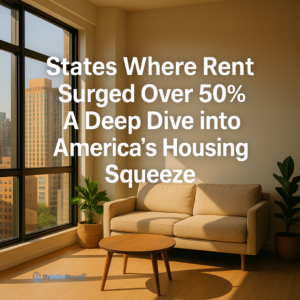The cost of renting a home in the United States has surged in the past five years, reshaping the housing landscape and straining the budgets of millions of Americans. According to Newsweek’s latest analysis, 10 states have seen rent prices jump by more than 50 percent between 2019 and 2024 a trend that highlights both regional migration patterns and the nation’s deepening housing shortage.
Read the full Newsweek report here.
The Big Picture: National Rent Trends
Across the country, rents have grown at an average pace of 31 percent in the last five years, bringing the median monthly rent to $1,302 in 2024. This increase is well above wage growth for most workers, creating what many experts now describe as a full-blown housing affordability crisis.
The steepest annual jump came in the immediate aftermath of the pandemic. Between 2021 and 2022 alone, rents rose by 8 percent nationwide, reflecting rapid demand recovery, limited housing supply, and inflationary pressures.
But while renters everywhere are paying more, some states have seen truly staggering increases.
The States Hit Hardest
Newsweek’s analysis revealed that 10 states experienced rent hikes of more than 50 percent, with Arizona topping the list at an eye-popping 84 percent increase.
-
Arizona: +84% (highest in the nation)
-
Tennessee: +67%
-
New Mexico: +65%
-
Alaska: +54%
-
Idaho: +54%
-
Montana: +54%
-
Wyoming: +53%
-
Georgia: +52%
-
Maryland: +51%
-
South Carolina: +51%
These figures come from a sample size of over 300,000 U.S. tenants, making the findings a significant reflection of real market conditions.
Why Are Rents Rising So Much?
Several factors have converged to push rents higher, particularly in the states above:
1. Migration & Relocation Trends
The pandemic accelerated domestic migration, as remote work allowed Americans to leave expensive urban hubs for more affordable and often sunnier regions. States like Arizona, Tennessee, and New Mexico became magnets for newcomers, driving up demand and rents.
2. Supply & Construction Gaps
Many of these states also face a shortfall in housing supply. Even as populations grow, new construction hasn’t kept pace. Zoning restrictions, high construction costs, and limited land availability have worsened the imbalance between supply and demand.
3. Lack of Rent Controls
Unlike cities such as New York or San Francisco, many of the fastest-rising states have little to no rent regulation. Landlords can adjust rents freely, particularly when local demand is strong and vacancy rates are low.
4. Inflation & Economic Conditions
From 2021 onward, inflation has affected not just everyday goods but also housing. Higher operating costs for property owners (maintenance, insurance, taxes) are often passed directly to tenants through rent increases.
The Human Impact
For renters, these increases are more than numbers on a chart. They represent real sacrifices and tough decisions:
-
Rent burden: When more than 30% of income goes to housing, households are considered “rent-burdened.” In many of these states, families are now paying 40–50% of their income on rent alone.
-
Forced relocations: Long-time residents are being priced out of their neighborhoods, while newcomers often struggle to find affordable entry points.
-
Ripple effects: Rising rents also drive up related costs from childcare options to commuting expenses as families move further from job centers.
Regional Case Studies
-
Arizona: Once known for affordability, Arizona’s population boom has collided with housing shortages. Cities like Phoenix and Tucson are now among the fastest-rising rental markets in the nation.
-
Tennessee: Cities such as Nashville and Memphis have become cultural and economic hubs, attracting both retirees and young professionals. But the surge in demand has far outpaced available rental housing.
-
Alaska & Montana: Even traditionally lower-density states are seeing rapid rent increases, partly due to limited housing stock and increased appeal during the pandemic for people seeking outdoor lifestyles.
Policy & Market Outlook
Experts suggest that without significant new construction or housing policy reforms, rents will remain elevated in these states. Some local governments are considering incentives for developers, while others debate introducing rent caps or tenant protections.
At the same time, the Federal Reserve’s interest rate policies continue to affect both mortgage markets and rental dynamics. Higher mortgage rates have sidelined many would-be homebuyers, keeping them in the rental pool longer and putting added pressure on rents.
What Renters Can Do
While systemic changes will take time, renters facing steep increases can take steps to protect themselves:
-
Negotiate leases: In competitive markets, some landlords are open to longer lease terms in exchange for lower annual increases.
-
Explore housing programs: State and federal assistance programs, as well as nonprofit housing support, can help eligible renters bridge affordability gaps.
-
Relocate strategically: Within the same metro area, some neighborhoods may still offer relative affordability.
-
Stay informed: Tracking rental market data helps renters anticipate changes and plan ahead.
Conclusion
The dramatic rent increases across these 10 states underscore the urgency of America’s housing crisis. With some regions facing rent hikes of more than 80 percent, the pressure on households, policymakers, and local economies is undeniable.
Unless housing supply expands significantly and affordability measures are prioritized, renters in these states may continue to shoulder disproportionate financial burdens in the years ahead.
Source: Newsweek – “Map Shows States Where Rent Increased by More Than 50 Percent”

